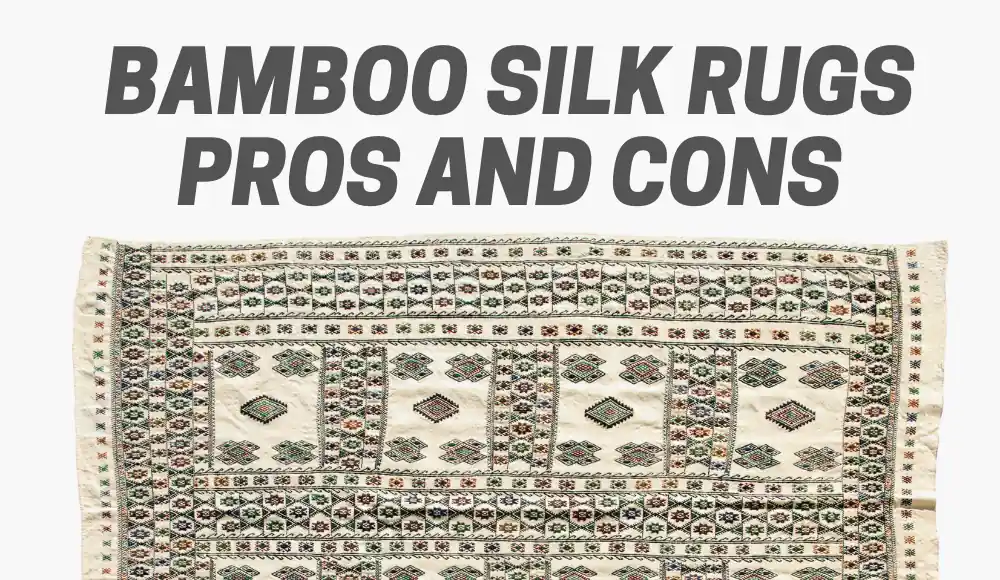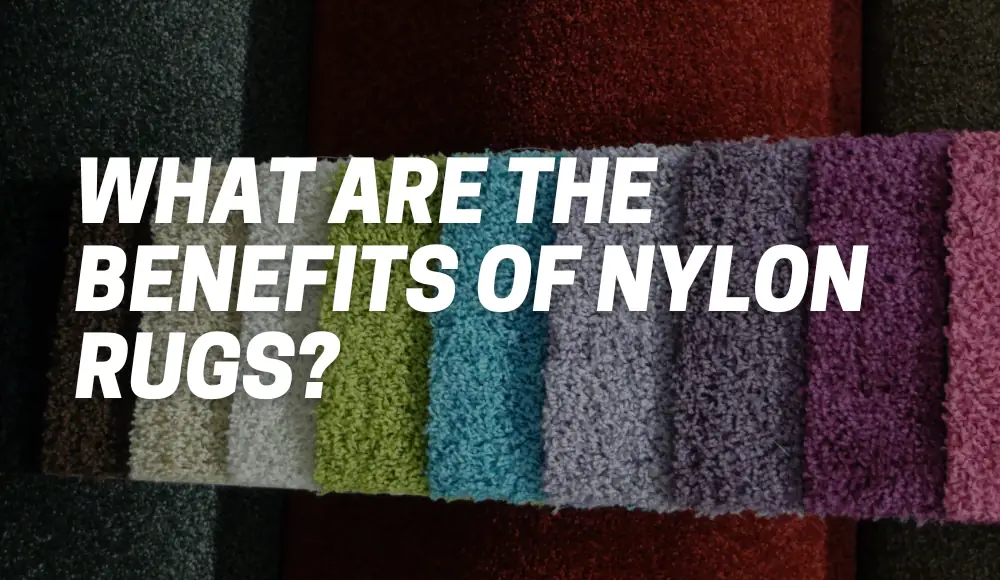Last updated on May 26th, 2024 at 06:24 am
Silk rugs exude an aura of luxury and sophistication, adorning homes with their intricate patterns and sumptuous texture. But beneath their beauty lies a question that often plagues potential buyers: Are silk rugs durable enough for everyday use? Let’s unravel the mystery and delve into the intricacies of silk rug durability.
Understanding Silk Rugs: A Delicate Balance of Beauty and Durability
Silk rugs, woven from the delicate threads of the silkworm, possess a unique blend of elegance and fragility. While silk is renowned for its lustrous sheen and soft touch, it’s natural to wonder whether these qualities translate into durability, especially in the context of daily wear and tear.
Are Silk Rugs Durable for Everyday Use?
Silk rugs, though exquisite, are not typically designed for heavy foot traffic or rugged use. Unlike their counterparts woven from wool or synthetic fibers, silk rugs require a more delicate touch and conscientious care. While they can withstand occasional use in low-traffic areas, subjecting silk rugs to constant footfall may compromise their longevity.
How Long Do Silk Rugs Typically Last?
The lifespan of a silk rug hinges on various factors, including quality, construction, and maintenance. On average, a well-maintained silk rug can last anywhere from 20 to 50 years, making it a long-term investment for discerning homeowners.
Do Silk Rugs Hold Up Well in High-Traffic Areas?
Silk rugs are best suited for areas with minimal foot traffic, such as formal living rooms or master bedrooms. Placing them in high-traffic zones like hallways or entryways exposes them to excessive wear and tear, diminishing their durability over time.
Factors Affecting the Durability of Silk Rugs
Silk rugs are known for their luxurious texture, sheen, and intricate designs. However, their durability can be influenced by several factors. Here are some key factors affecting the durability of silk rugs:
- Silk Quality:
- The quality of the silk used in the rug significantly impacts its durability. Higher-quality silk fibers are more resilient and less prone to damage.
- Density of Knots:
- The number of knots per square inch in a silk rug contributes to its durability. Rugs with a higher knot density tend to be more durable as they can withstand wear and tear better.
- Weave Type:
- The weaving technique used plays a role in the durability of silk rugs. Hand-knotted silk rugs are generally more durable than machine-made ones. The tightness of the weave and the skill of the weaver are crucial factors.
- Pile Height:
- A shorter pile height in a silk rug is often associated with better durability. Shorter piles are less prone to crushing and matting, making the rug more resilient to foot traffic.
- Dye Quality:
- The quality of dyes used in the coloring of silk rugs can affect their longevity. Poor-quality dyes may fade over time, diminishing the overall appearance of the rug.
- Exposure to Sunlight:
- Prolonged exposure to direct sunlight can cause silk fibers to deteriorate and colors to fade. It’s advisable to place silk rugs in areas with minimal exposure to sunlight or to use window coverings to protect them.
- Maintenance and Cleaning:
- Regular and proper maintenance is crucial for the longevity of silk rugs. Gentle vacuuming, avoiding harsh chemicals, and prompt cleaning of spills can help prevent damage.
- Environmental Conditions:
- Extreme environmental conditions, such as high humidity or excessive dryness, can affect silk fibers. It’s essential to maintain a stable environment to prevent the silk from becoming brittle or prone to mold and mildew.
- Traffic Levels:
- The amount of foot traffic a silk rug experiences influences its durability. Placing silk rugs in low-traffic areas helps preserve their beauty and integrity.
- Proper Padding:
- Using a suitable rug pad can provide additional support and cushioning, reducing the impact of foot traffic and preventing the rug from slipping, which can contribute to wear and tear.
Can Silk Rugs Withstand Pets and Children?
Silk rugs, sensitive to moisture and staining, may not be the most practical choice for households with pets and young children. Accidental spills, pet accidents, and playful antics can pose challenges to maintaining the integrity of silk rugs, necessitating extra caution and vigilance.
Rug Fringe Replacement: Complete Guide, Types, Costs, and DIY Tips
Maintaining the Durability of Silk Rugs
Preserving the durability of silk rugs requires diligence and attention to detail:
- Regular Vacuuming:
- Vacuum your silk rug regularly to remove dust, dirt, and debris. Use a vacuum cleaner with a gentle suction and a brushless nozzle to avoid damaging the delicate silk fibers. Vacuum in the direction of the pile to prevent pulling.
- Rotate the Rug:
- Rotate the silk rug periodically to ensure even wear. This is especially important in high-traffic areas where foot traffic tends to concentrate. Rotating the rug helps distribute wear and tear more evenly.
- Use a Rug Pad:
- Place a high-quality rug pad underneath your silk rug to provide extra cushioning and prevent slipping. A rug pad also helps protect the rug from abrasion and reduces the impact of foot traffic.
- Avoid Direct Sunlight:
- Limit exposure to direct sunlight, as prolonged UV exposure can cause silk fibers to weaken and colors to fade. Use window coverings, such as blinds or curtains, to protect the rug from harsh sunlight.
- Professional Cleaning:
- When necessary, have your silk rug professionally cleaned. Avoid using harsh chemicals or cleaning solutions, as they can damage the delicate fibers. Professional cleaners with experience in handling silk rugs can ensure a safe and thorough cleaning process.
- Address Spills Promptly:
- Attend to spills immediately to prevent stains. Blot the affected area with a clean, dry cloth or paper towel to absorb the liquid. Avoid rubbing the stain, as it can push the substance deeper into the fibers. Seek professional cleaning for stubborn stains.
- Control Humidity Levels:
- Maintain a stable indoor environment with moderate humidity levels. Extreme humidity can lead to mold and mildew growth, while excessive dryness may cause silk fibers to become brittle. Use dehumidifiers or humidifiers as needed.
- Store Properly:
- If you need to store a silk rug, clean it thoroughly first. Roll the rug with the pile facing inward and wrap it in a breathable material like cotton. Store it in a cool, dry place to prevent moisture damage.
- Avoid Heavy Furniture:
- Minimize the placement of heavy furniture on silk rugs to prevent crushing and indentation. Use furniture pads or coasters under the legs of heavy items to distribute the weight more evenly.
- Inspect Regularly:
- Periodically inspect the silk rug for any signs of wear, damage, or loose fibers. Promptly address any issues to prevent further deterioration.
Differences in Durability: Silk vs. Wool vs. Synthetic Fibers
| Feature | Silk Rugs | Wool Rugs | Synthetic Rugs |
|---|---|---|---|
| Durability | Moderate | High | Variable |
| Maintenance | High maintenance; delicate fibers | Moderate maintenance; resilient fibers | Low maintenance; durable and stain-resistant |
| Longevity | 20-50 years | 50+ years | 10-20 years |
| Cost | Expensive | Moderate | Affordable |
| Traffic Tolerance | Low | High | High |
Special Care for Silk Rug Durability
- Avoid Direct Sunlight: Prolonged exposure to sunlight can fade and weaken silk fibers, so place rugs away from windows or use UV-protective window treatments.
- Rotate Regularly: Rotate silk rugs periodically to ensure even wear and prevent excessive fading or discoloration in specific areas.
Best Rugs for Office Chairs [Protect Your Floors with Function]
Common Issues Affecting Silk Rug Durability
- Fading: Sunlight exposure and improper cleaning methods can cause silk rugs to lose their vibrancy over time.
- Shedding: Silk rugs may shed initially as loose fibers work their way out of the weave, but this typically diminishes with regular use and vacuuming.
- Water Damage: Silk rugs are highly susceptible to water damage, so avoid excessive moisture and promptly dry any spills or accidents.
Quality of Silk and its Impact on Durability
The quality of silk used in rugs has a significant impact on their durability, appearance, and overall performance. Several factors contribute to the quality of silk, and understanding these aspects is crucial when assessing the durability of silk rugs. Here are key factors related to silk quality and their impact on rug durability:
- Silk Fiber Type:
- The type of silk fiber used in rug making can affect its durability. Mulberry silk, derived from the silkworms that feed on mulberry leaves, is considered the highest quality and is often used in premium silk rugs. Mulberry silk fibers are longer, smoother, and more uniform, contributing to the overall strength and durability of the rug.
- Fiber Thickness:
- Thicker silk fibers generally result in a more durable rug. Thin fibers are more prone to breakage and wear, impacting the longevity of the rug. High-quality silk rugs typically use finer fibers to achieve a luxurious feel while maintaining durability.
- Fiber Strength:
- The tensile strength of silk fibers is a crucial factor in determining durability. Silk is inherently strong, and high-quality silk has better tensile strength, making it more resistant to pulling, stretching, and abrasion.
- Fiber Purity:
- Pure silk, without impurities or added synthetic fibers, is preferred for high-quality rugs. The presence of impurities can weaken the silk and reduce its overall durability. Authentic silk rugs should be labeled as 100% silk.
- Color Saturation:
- The ability of silk to absorb and retain color impacts the vibrancy and longevity of the rug’s design. High-quality silk allows for better color saturation, ensuring that the colors remain vibrant over time and resist fading.
- Sheen and Luster:
- The natural sheen and luster of silk are desirable characteristics that enhance the visual appeal of silk rugs. High-quality silk fibers contribute to a luxurious sheen, and this sheen can be an indicator of the silk’s overall quality.
- Smoothness of Texture:
- Fine silk fibers with a smooth texture contribute to the softness and comfort of silk rugs. The smoothness also affects the rug’s ability to resist matting and crushing, contributing to its overall durability.
- Resistance to Wear:
- High-quality silk rugs are more resistant to wear and abrasion. The combination of strong, fine fibers with good tensile strength ensures that the rug can withstand foot traffic and daily use without showing signs of significant wear.
- Durability in Different Climates:
- Silk rugs made from high-quality silk are more adaptable to different climates. They are less likely to become brittle in dry conditions or prone to mold and mildew in humid environments.
- Craftsmanship:
- The skill of the weaver and the attention to detail during the rug-making process also play a role in the overall durability of a silk rug. A well-crafted rug with high-quality silk is likely to have better longevity.
When purchasing a silk rug, it’s essential to inquire about the type of silk used, the weaving technique, and the overall craftsmanship. A combination of these factors contributes to the durability, beauty, and value of silk rugs.
Types of Silk Rugs: Variations in Durability
Silk rugs come in various types, each with its own characteristics and variations in terms of durability. The type of silk used, the weaving technique, and other factors can influence how well a silk rug stands up to wear and tear. Here are some common types of silk rugs and considerations regarding their durability:
- Hand-Knotted Silk Rugs:
- Hand-knotted silk rugs are often considered the most luxurious and durable among silk rugs. Skilled artisans hand-tie individual knots to create intricate patterns. The tight knotting and craftsmanship contribute to the overall durability of these rugs.
- Hand-Tufted Silk Rugs:
- Hand-tufted silk rugs are made using a different process where a tufting gun is used to punch strands of silk into a canvas backing. While they may have a similar appearance to hand-knotted rugs, hand-tufted silk rugs are generally less durable due to the looser construction.
- Machine-Made Silk Rugs:
- Machine-made silk rugs are produced using automated looms. While they may be more affordable, they are typically less durable than handmade options. The machine-made rugs often lack the intricate detailing and tight knotting found in hand-knotted rugs, affecting their overall longevity.
- Silk and Wool Blend Rugs:
- Some rugs combine silk with other fibers, such as wool. While these blends can result in a softer texture, the durability may vary depending on the ratio of silk to wool. Wool is generally more resilient, so a higher percentage of silk may impact the rug’s ability to withstand heavy use.
- Flatweave Silk Rugs:
- Flatweave silk rugs are woven on a loom without pile. While they can be quite durable, their construction may not provide the same level of softness as pile rugs. Flatweave silk rugs are often used in areas with moderate foot traffic.
- Traditional Persian Silk Rugs:
- Traditional Persian silk rugs, such as those from cities like Kashan, Qum, or Isfahan, are highly regarded for their craftsmanship. These rugs often feature intricate designs and high-quality silk, contributing to their durability. However, the specific durability can still vary based on factors like knot density and maintenance.
- Modern and Contemporary Silk Rugs:
- Modern and contemporary silk rugs may incorporate innovative designs and color schemes. The durability of these rugs depends on factors like silk quality, weave type, and overall construction. Some modern designs may prioritize aesthetics over traditional durability.
- Antique Silk Rugs:
- Antique silk rugs, often considered collector’s items, can vary in durability based on their age, condition, and how well they’ve been preserved. While some antique silk rugs are still remarkably durable, others may require more delicate handling.
Hand-knotted silk rugs, especially those from reputable weaving regions, tend to offer a good balance of luxury and durability. However, personal preferences and the rug’s intended location also play a role in the selection process. Regular care and maintenance are essential for preserving the beauty and longevity of any silk rug.
In conclusion
While silk rugs exude opulence and allure, their durability hinges on a delicate balance of care and caution. By understanding the nuances of silk rug maintenance and investing in high-quality craftsmanship, homeowners can enjoy the timeless elegance of silk rugs for generations to come.


